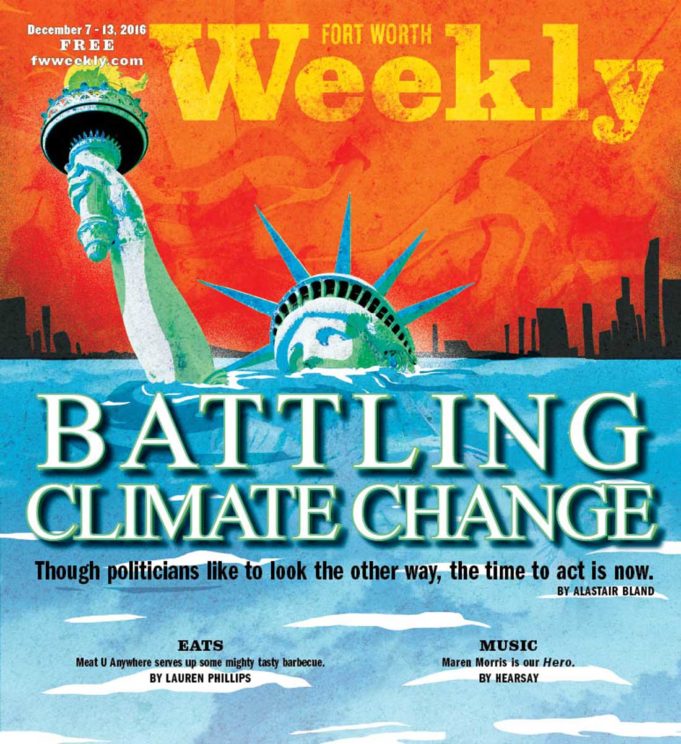If President-elect Donald Trump actually believes all the warnings he issued during the election about the threats of immigration, he should be talking about ways to slow global warming as well. Rising sea level, caused by the melting of the Antarctic and Greenland ice caps, will probably displace tens of millions of people in the decades ahead, and many may come to North America as refugees.
Climate change will cause a suite of other problems for future generations to tackle, and it’s arguably the most pressing issue of our time. A year ago this month, world leaders gathered in Paris to discuss strategies for curbing greenhouse gas emissions, and scientists at every corner of the globe confirm that humans are facing a crisis. However, climate change is being nearly ignored by American politicians and lawmakers. It was not discussed in depth at all during this past election cycle’s televised presidential debates. And when climate change does break the surface of public discussion, it polarizes Americans like almost no other political issue. Some conservatives, including Trump, still deny there’s even a problem.
“We are in this bizarre political state in which most of the Republican Party still thinks it has to pretend that climate change is not real,” said Jonathan F.P. Rose, a New York City developer and author of The Well-Tempered City, which explores in part how low-cost green development can mitigate the impacts of rising global temperatures and changing weather patterns.
Rose says progress cannot be made in drafting effective climate strategies until national leaders agree there’s an issue.
“We have such strong scientific evidence,” he said. “We can disagree on how we’re going to solve the problems, but I would hope we could move toward an agreement on the basic facts.”
That such a serious planetwide crisis has become a divide across the American political battlefield “is a tragedy” to Peter Kalmus, an earth scientist with the Jet Propulsion Laboratory at California Institute of Technology in Pasadena, who agreed to be interviewed for this story on his own behalf (not on behalf of NASA, JPL, or Caltech).
Kalmus warns that climate change is happening whether politicians want to talk about it or not.
“CO2 molecules and infrared photons don’t give a crap about politics, whether you’re liberal or conservative, Republican or Democrat, or anything else,” Kalmus said.
Slowing climate change will be essential, since adapting to all its impacts may be impossible. Governments must strive for greater resource efficiency, shift to renewable energy, and transition from conventional to more sustainable agricultural practices.
America’s leaders must also implement a carbon pricing system, climate activists say, that places a financial burden on fossil fuel producers and reduces greenhouse gas emissions. But there may be little to zero hope that such a system will be installed at the federal level as Trump prepares to move into the White House. Trump has actually threatened to reverse any commitments the United States agreed to in Paris. According to widely circulating reports, Trump has even selected a well-known skeptic of climate change, Myron Ebell, to head his U.S. Environmental Protection Agency transition team. Ebell is the director of the Center for Energy and Environment at the Competitive Enterprise Institute.
Steve Valk, communications director for the Citizens’ Climate Lobby, says the results of the presidential election come as a discouraging setback in the campaign to slow emissions and global warming.
“There’s no doubt that the steep hill we’ve been climbing just became a sheer cliff,” he said. “But cliffs are scalable.”
Valk says the American public must demand that Congress implement carbon pricing. He says the government is not likely to face and attack climate change unless voters force them to.
“The solution is going to have to come from the people,” he said. “Our politicians have shown that they’re just not ready to implement a solution on their own.”
After Paris
There is no question the Earth is warming rapidly, and already this upward temperature trend is having impacts. It is disrupting agriculture. Glacial water sources are vanishing. Storms and droughts are becoming more severe. Altered winds and ocean currents are impacting marine ecosystems. So is ocean acidification, another outcome of carbon dioxide emissions. The sea is rising and eventually will swamp large coastal regions and islands. As many as 200 million people could be displaced by 2050. For several years in a row now, each year has been warmer than any year prior in recorded temperature records, and by 2100 it may be too hot for people to permanently live in the Persian Gulf.

World leaders and climate activists made groundbreaking progress toward slowing these effects at the Paris climate conference. Here, leaders from 195 countries drafted a plan of action to reduce global greenhouse gas emissions and steer the planet off its predicted course of warming. The pact, which addresses energy, transportation, industries, and agriculture — and which asks leaders to regularly upgrade their climate policies — is intended to keep the planet from warming by 2.7 degrees Fahrenheit between pre-industrial years and the end of this century. Scientists have forecasted that an average global increase of 3.6 degrees Fahrenheit will have devastating consequences for humanity.
The United States pledged to cut greenhouse gas emissions by 26 percent from 2005 levels within a decade. China, Japan, and nations of the European Union made similar promises. More recently, almost 200 nations agreed to phase out hydrofluorocarbons, extremely potent but short-lived greenhouse gases emitted by refrigerators and air-conditioners, and reduce the emissions from the shipping and aviation industries.
But in the wake of such promising international progress, and as 2016 draws to a close as the third record-warm year in a row, many climate activists are disconcerted both by United States leaders’ recent silence on the issue and by the outcome of the presidential election. Mark Sabbatini, editor of the newspaper Icepeople in Svalbard, Norway, believes shortsighted political scheming has pushed climate change action to the back burner. He wants to see politicians start listening to scientists.
“But industry folks donate money, and scientists get shoved aside in the interest of profits and re-election,” said Sabbatini, who recently had to evacuate his apartment as unprecedented temperatures thawed out the entire region’s permafrost, threatening to collapse buildings.
Short-term goals and immediate financial concerns distract leaders from making meaningful policy advances on climate.
“In Congress, they look two years ahead,” Sabbatini said. “In the Senate, they look six years ahead. In the White House, they look four years ahead.”
 The 300 nationwide chapters of the Citizens’ Climate Lobby are calling on local governments and chambers of commerce across America to voice support for a revenue-neutral carbon fee. The hope is that leaders in Congress will hear the demands of the people. This carbon fee would impose a charge on producers of oil, natural gas, and coal. As a direct result, all products and services that depend on or directly utilize those fossil fuels would cost more for consumers, who would be incentivized to buy less. Food shipped in from far away would cost more than locally grown alternatives. Gas for heating, electricity generated by oil and coal, and driving a car would become more expensive.
The 300 nationwide chapters of the Citizens’ Climate Lobby are calling on local governments and chambers of commerce across America to voice support for a revenue-neutral carbon fee. The hope is that leaders in Congress will hear the demands of the people. This carbon fee would impose a charge on producers of oil, natural gas, and coal. As a direct result, all products and services that depend on or directly utilize those fossil fuels would cost more for consumers, who would be incentivized to buy less. Food shipped in from far away would cost more than locally grown alternatives. Gas for heating, electricity generated by oil and coal, and driving a car would become more expensive.
“Bicycling would become more attractive, and so would electric cars and home appliances that use less energy,” said Kalmus, an advocate of the revenue-neutral carbon fee.
Promoting this fee system is essentially the Citizens’ Climate Lobby’s entire focus.
“This would be the most important step we take toward addressing climate change,” Valk said.
By the carbon fee system, the revenue from fossil fuel producers would be evenly distributed by the collecting agencies among the public, perhaps via a tax credit. Recycling the dividends back into society would make it a fair system, Valk explains, since poorer people, who tend to use less energy than wealthier people to begin with and are therefore less to blame for climate change, would come out ahead.
The system would also place a tariff on incoming goods from nations without a carbon fee. This would keep American industries from moving overseas and maybe even prompt other nations to set their own price on carbon.
But there’s a problem with the revenue-neutral carbon fee, according to other climate activists: It doesn’t support social programs that may be aimed at reducing society’s carbon footprint.
“It will put no money into programs that serve disadvantaged communities who, for example, might not be able to afford weatherizing their home and lowering their energy bill, or afford an electric vehicle or a solar panel,” said Renata Brillinger, executive director of the California Climate and Agriculture Network. “It doesn’t give anything to public schools for making the buildings more energy-efficient, and it wouldn’t give any money to farmers’ incentive programs for soil building.”
Brillinger’s organization is advocating for farmers to adopt practices that actively draw carbon out of the atmosphere, like planting trees and maintaining ground cover to prevent erosion. Funding, she says, is needed to support such farmers, who may go through transitional periods of reduced yields and increased costs. California’s cap-and-trade system sets up an ample revenue stream for this purpose that a revenue-neutral system does not, according to Brillinger.
But Valk says establishing a carbon pricing system must take into account the notorious reluctance of conservatives in Congress.
“You aren’t going to get a single Republican in Congress to support legislation unless it’s revenue-neutral,” he said. “Any policy is useless if you can’t pass it in Congress.”
Sequestering the farm
In Washington, D.C., the nation’s leaders continue tussling over popular issues like immigration, taxes, healthcare, abortion, guns and foreign affairs.
Climate change activists wish they would be thinking more about soil. That’s because stopping greenhouse gas emissions alone will not stop climate change. The carbon dioxide emitted through centuries of industrial activity will continue to drive warming unless it is removed from the air and put somewhere.
“There are only three places carbon can go,” Brillinger said. “It can go into the atmosphere, where we don’t want it, into the ocean, where we also don’t want it because it causes acidification, or into soil and woody plants where we do want it. Carbon is the backbone of all forests and is a critical nutrient of soil.”
But most of the Earth’s soil carbon has been lost to the atmosphere, causing a spike in atmospheric carbon. In the 1700s, the Earth’s atmosphere contained less than 280 parts per million of carbon dioxide, according to scientists. Now, we are at more than 400 and counting. Climate experts generally agree that the atmospheric carbon level must be reduced to 350 or less if we are to keep at bay the most disastrous possible impacts of warming.
This is why farmers and the soil they work will be so important in mitigating climate change. By employing certain practices and abandoning other ones, farmers and ranchers can turn acreage into valuable carbon sinks — a general agricultural approach often referred to as “carbon farming.”
Conventional agriculture practices tend to emit carbon dioxide. Regular tilling of the soil, for example, causes soil carbon to bond with oxygen and float away as carbon dioxide. Tilling also causes erosion, as do deforestation and overgrazing. With erosion, soil carbon enters waterways, creating carbonic acid — the direct culprit of ocean acidification. Researchers have estimated that unsustainable farming practices have caused as much as 80 percent of the world’s soil carbon to turn into carbon dioxide.
By carbon farming, those who produce the world’s food can simultaneously turn their land into precious carbon sinks. The basic tenets of carbon farming include growing trees as windbreaks and focusing on perennial crops, like fruit trees and certain specialty grain varieties, which demand less tilling and disturbance of the soil.
Eric Toensmeier, a senior fellow with the climate advocacy group Project Drawdown and the author of The Carbon Farming Solution, says many other countries are far ahead of the United States in both recognizing the importance of soil as a place to store carbon and funding programs that help conventional farmers shift toward carbon farming practices. France, for instance, initiated a sophisticated program in 2011 that calls for increasing soil carbon worldwide by 0.4 percent every year. Healthy soil can contain 10 percent carbon or more, and France’s program has the potential over time to decelerate the increase in atmospheric carbon levels.
Toensmeier is optimistic about the progress being made in the United States, too. The U.S. Department of Agriculture funds programs that support environmentally friendly farming practices that protect watersheds or enhance wildlife habitat, largely through planting perennial grasses and trees.
“And it turns out a lot of the practices they’re paying farmers to do to protect water quality or slow erosion also happen to sequester carbon,” Toensmeier said.
He says it appears obvious that the federal government is establishing a system by which they will eventually pay farmers directly to sequester carbon. Such a direct faceoff with climate change, however, may be a few years away still.
Climate activists may even need to wait until 2021.
“First we need a president who acknowledges that climate change exists,” Toensmeier said.
National Politics and City Reform
Climate reform advocates still talk about Bernie Sanders’ fiery attack on fracking as a source of global warming in the May primary debate with Hillary Clinton.
“If we don’t get our act together, this planet could be 5 to 10 degrees warmer by the end of this century,” Sanders said then. “Cataclysmic problems for this planet. This is a national crisis.”
 Sanders was not exaggerating. The Earth has already warmed by 1.7 degrees Fahrenheit since 1880, and it’s getting hotter. Even with the advances made in Paris, the world remains on track to be 6.1 degrees Fahrenheit warmer by 2100 than it was in pre-industrial times, according to a United Nations emissions report released in early November. The authors of another paper published in January in the journal Nature predicted temperatures will rise as much as 10 degrees Fahrenheit.
Sanders was not exaggerating. The Earth has already warmed by 1.7 degrees Fahrenheit since 1880, and it’s getting hotter. Even with the advances made in Paris, the world remains on track to be 6.1 degrees Fahrenheit warmer by 2100 than it was in pre-industrial times, according to a United Nations emissions report released in early November. The authors of another paper published in January in the journal Nature predicted temperatures will rise as much as 10 degrees Fahrenheit.
In light of the scientific consensus, conservatives’ denial of climate change looks childish at best and dangerous at worst. In low-lying Florida, so vulnerable to the rising sea, an unofficial policy from its Republican leadership has effectively muzzled state employees from even mentioning “climate change” and “global warming” in official reports and communications. Here in Texas, Ted Cruz suggested NASA focus its research less on climate change and more on space exploration, according to The Christian Science Monitor.
Most frightening of all, maybe, is the incoming American president’s stance on the matter: Trump said in a 2012 tweet that global warming is a Chinese hoax. In January 2014, during a brief spell of cold weather, he asked via Twitter, “Is our country still spending money on the GLOBAL WARMING HOAX?”
While most of the rest of the world remains poised to advance emissions reductions goals, Trump is aiming in a different direction. The Trump-Pence website vows to “unleash America’s $50 trillion in untapped shale, oil, and natural gas reserves, plus hundreds of years in clean coal reserves.” His webpage concerning energy goals mentions only reducing emissions once, and it makes no mention of climate change or renewable energy.
While meaningful action at the federal level is probably years away, at the local level, progress is coming — even in communities led by Republicans, according to Rose. That, he says, is because local politicians face a level of accountability from which national leaders are often shielded.
“At the city level, mayors have to deliver real results,” Rose said. “They have to protect their residents and make wise investments on behalf of their residents. The residents see what they’re doing and hold them accountable.”

Restructuring and modifying our cities, which are responsible for about half of America’s carbon footprint, “will be critical toward dealing with climate change,” Rose said.
“On the coast, we’ll have sea levels rise,” he said. “Inland, we’ll have flooding and heat waves. Heat waves cause more deaths than hurricanes.”
Simply integrating nature into city infrastructure is a very low-cost but effective means for countering the changes that are coming, Rose says. Many cities, for example, are planting thousands of street trees. Trees draw in atmospheric carbon as they grow and, through shade and evaporative cooling effects, can significantly reduce surface temperatures by as much as 6 degrees Fahrenheit in some circumstances, Rose says.
Laws and policies that take aim at reduced emissions targets can be very efficient tools for generating change across entire communities. However, Kalmus believes it’s important that individuals, too, reduce their own emissions through voluntary behavior changes, rather than simply waiting for change to come from leaders and lawmakers.
“If you care about climate change, it will make you happier,” he said. “It makes you feel like you’re pioneering a new way to live. For others, you’re the person who is showing the path and making them realize it’s not as crazy as it seems.”
Kalmus, who lives in Altadena, Calif., with his wife and two sons, has radically overhauled his lifestyle to reduce his carbon footprint. Since 2010 he has cut his own emissions by a factor of 10 — from 20 tons per year to just 2, by his own estimates. This personal transformation is the subject of his forthcoming book, Being the Change: Live Well and Spark a Climate Revolution, due out in 2017.
Kalmus rides a bike most places, eats mostly locally grown food, raises some of it in his own yard, has stopped eating meat and — one of the most important changes — has all but quit air travel.
He hopes to serve as a model and help spark a transition to an economy that does not depend on constant growth, as ours currently does. One day, he believes, it will be socially unacceptable to burn fossil fuel, just as it’s become shunned to waste water in drought-dried California. The oil industry will eventually become obsolete.
“We need to transition to an economy that doesn’t depend on unending growth,” Kalmus said.
Unless we slow our carbon emissions and our population growth now, depletion of resources, he warns, will catch up with us.
“We need to shift to a steady-state economy and a steady-state population,” he said. “Fossil-fueled civilization cannot continue forever.”
Though Americans will soon have as president a man who is essentially advocating for climate change, Valk, at the Citizens’ Climate Lobby, expects time — and warming — to shift voter perspectives.
“As more and more people are personally affected by climate change, like those recently flooded out in Louisiana and North Carolina,” he said, “people of all political persuasions will see that acting on climate change is not a matter of partisan preferences, but a matter of survival.”
A freelance journalist in San Francisco, Alastair Bland writes about water, fisheries, agriculture, and the environment, and his work has appeared at NPR.org, SmithsonianMag.com, the Sacramento News & Review, and Yale E360.













Below I offer a selection from the teachings of Maitreya, the World Teacher, who is emerging publicly at this time. Many more insightful teachings like these covering a vast array of topics (politics, the inner self, economic structures, religious salvation and detachment, UFOs…) were given between 1988 – 1993 through one of his associates in London and compiled into the book, “Maitreya’s Teachings: The Laws of Life”. Many people were astounded at the accuracy of the forecasts of major events just prior to their happening, including the release of Nelson Mandela, the fall of Margaret Thatcher, and the collapse of the Soviet Union. Maitreya is an extraordinarily evolved “Elder brother” of humanity who is stepping forward to inspire us to unite on common ground to call upon our leaders to share the world’s food and basic resources — to end needless hunger and the threat of any nuclear war. Sharing is the only truly sustainable path in this 21st century, if we wish to build peace and rehabilitate our planet back to health. Nations are realizing their interdependence when it comes to security and protecting the natural commons (beyond human man-made boundaries). Sharing will engender trust and cooperation among governments. Sharing will allow poorer nations to resist the reckless exploitation of their forests and waterways for the sake of economic survival. Sharing will lead to less waste of food and other commodities.
“Everything around us has been created by nature, but disasters, destruction, depression and disease are man-made. The people you must demand an answer from are your leaders, those who have conditioned you and prevented you from enjoying a life of bliss and peace. The energy which is wreaking havoc in the world now through storms, earthquakes and volcanic eruptions has been unleashed because man thinks he can do what he likes. He believes that if he has a healthy bank balance he has a healthy life. But greed drives him to destruction. Spiritually and mentally he is bankrupt. We are seeing the end of the old age and the beginning of a new era.”
“The environment will become the number one issue throughout the world.”
(Maitreya’s associate, Share International, June 1989)
Suggested reading: “SOP – Save Our Planet” – Share International Magazine
http://www.share-international.org/magazine/old_issues/2012/2012-10.htm#Mestari
Wow. No local content at all. I guess DFW doesn’t have an environmental groups……..